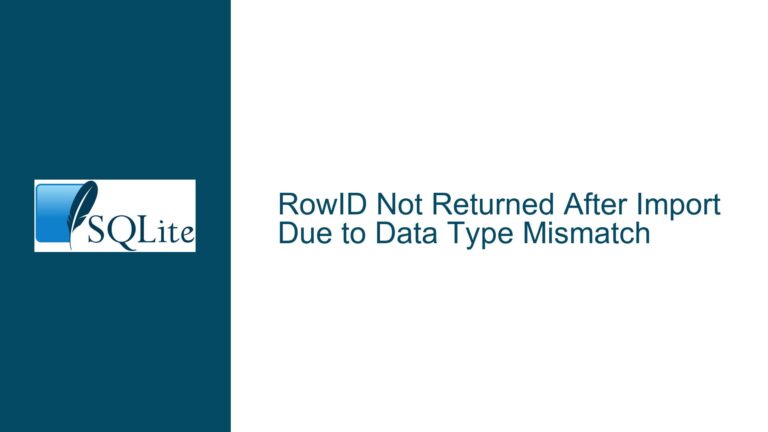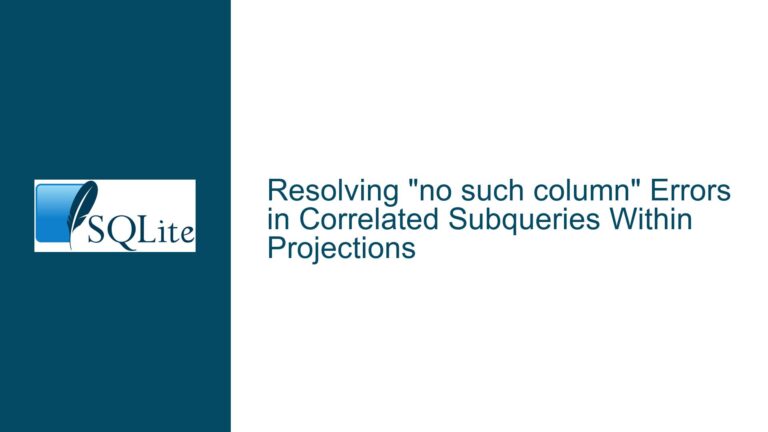Finding the Lowest Unused ID in SQLite: Efficient Gap Detection and Reuse
Understanding the Problem: Finding the Lowest Unused ID in a Table
The core issue revolves around efficiently identifying the smallest unused ID in an SQLite table, particularly when records are deleted, leaving gaps in the sequence of IDs. The user wants to reuse these gaps, starting from the lowest available ID, which is often 1. This is a common scenario in systems where IDs are used to reference external resources, such as files, and reusing IDs helps maintain a compact and consistent naming scheme.
The user’s initial approach involves a query that attempts to find the first gap in the sequence of IDs. However, this query fails to handle the case where the first ID (1) is deleted, as it only checks for gaps starting from the minimum existing ID. The user also expresses a preference for avoiding multiple queries and seeks a more elegant, single-query solution.
The discussion highlights several key points:
- The user’s table schema does not use
INTEGER PRIMARY KEY, which would allow SQLite to automatically manage IDs. - The user’s current query logic is flawed when the first ID is missing.
- There are multiple potential solutions, ranging from SQL query optimizations to schema redesigns and the use of triggers or auxiliary tables.
Why Reusing IDs Can Be Problematic and When It Makes Sense
Reusing IDs in a database is generally discouraged for several reasons:
- Data Integrity: Reusing IDs can lead to confusion, especially if external systems or logs reference these IDs. If an ID is reused, historical data might become ambiguous.
- Performance: Continuously searching for gaps in the ID sequence can be computationally expensive, especially as the table grows.
- Complexity: Managing reused IDs requires additional logic, such as tracking deleted IDs or ensuring that gaps are filled correctly.
However, there are valid use cases for reusing IDs:
- File Naming: If IDs are used to name external files (as in the user’s case), reusing IDs can keep filenames short and consistent.
- Limited ID Space: In rare cases where the ID space is limited (e.g., 32-bit integers), reusing IDs can prevent exhaustion of available IDs.
- Aesthetic or Organizational Preferences: Some developers prefer to maintain a dense sequence of IDs for readability or organizational purposes.
Given these trade-offs, the user’s desire to reuse IDs is understandable but requires careful implementation to avoid pitfalls.
Solutions and Best Practices for Finding and Reusing Unused IDs
1. Using SQLite’s Built-in Features: INTEGER PRIMARY KEY
The simplest and most efficient solution is to leverage SQLite’s INTEGER PRIMARY KEY feature. When a column is declared as INTEGER PRIMARY KEY, SQLite automatically assigns a unique, incrementing value to it. This eliminates the need to manually manage IDs and ensures that IDs are always unique.
However, this approach does not reuse deleted IDs. If reusing IDs is a strict requirement, this solution may not suffice. Nonetheless, it is worth considering because it simplifies the schema and improves performance.
Example:
CREATE TABLE Image (
myid INTEGER PRIMARY KEY,
site TEXT,
category TEXT,
username TEXT,
siteid TEXT,
currentpath TEXT,
originalfile_bool INTEGER,
originalpath_bool INTEGER,
bytes INTEGER,
archived_bool INTEGER
);
With this schema, inserting a new record without specifying myid will automatically assign the next available ID.
2. Finding the Lowest Unused ID with a Single Query
If reusing IDs is necessary, the user’s query can be improved to handle the case where the first ID (1) is missing. The following query uses a UNION to check for the availability of ID 1 and then searches for the next gap in the sequence:
SELECT 1 AS newid
WHERE newid NOT IN (SELECT myid FROM Image)
UNION ALL
SELECT myid + 1 AS newid
FROM Image
WHERE newid NOT IN (SELECT myid FROM Image)
LIMIT 1;
This query works as follows:
- The first part checks if ID 1 is available. If it is, it returns 1.
- The second part searches for the first gap in the sequence of existing IDs.
- The
LIMIT 1ensures that only the smallest available ID is returned.
This approach is efficient because it combines both checks into a single query and stops as soon as it finds a valid ID.
3. Using Triggers to Track Deleted IDs
Another approach is to use triggers to maintain a separate table of available IDs. This method is particularly useful if IDs are frequently deleted and reused.
Example:
-- Table to store available IDs
CREATE TABLE FreeIDs (
myid INTEGER PRIMARY KEY
);
-- Trigger to add deleted IDs to the FreeIDs table
CREATE TRIGGER TrackDeletedIDs
AFTER DELETE ON Image
FOR EACH ROW
BEGIN
INSERT INTO FreeIDs (myid) VALUES (OLD.myid);
END;
-- Trigger to remove reused IDs from the FreeIDs table
CREATE TRIGGER TrackReusedIDs
AFTER INSERT ON Image
FOR EACH ROW
BEGIN
DELETE FROM FreeIDs WHERE myid = NEW.myid;
END;
To find the lowest available ID, simply query the FreeIDs table:
SELECT MIN(myid) FROM FreeIDs;
This approach ensures that finding an available ID is fast, as it only requires a simple query on a small table.
4. Using a Deletion Flag Instead of Deleting Records
Instead of deleting records, you can mark them as inactive and reuse their IDs. This approach avoids the need to track deleted IDs explicitly.
Example:
ALTER TABLE Image ADD COLUMN active INTEGER DEFAULT 1;
-- To "delete" a record
UPDATE Image SET active = 0 WHERE myid = ?;
-- To find the first inactive record
SELECT MIN(myid) FROM Image WHERE NOT active;
This method is efficient and avoids the complexity of managing a separate table for deleted IDs.
5. Using Window Functions to Identify Gaps
For advanced users, SQLite’s window functions can be used to identify gaps in the ID sequence. This approach is more complex but can be useful for occasional gap detection.
Example:
WITH IDs AS (
SELECT myid, LEAD(myid) OVER (ORDER BY myid) AS nextid
FROM Image
)
SELECT myid + 1 AS newid
FROM IDs
WHERE nextid > myid + 1
LIMIT 1;
This query identifies gaps by comparing each ID with the next ID in the sequence. It is efficient for occasional use but may not be suitable for frequent gap detection in large tables.
Conclusion: Choosing the Right Approach
The best solution depends on the specific requirements and constraints of your application:
- If reusing IDs is not strictly necessary, use
INTEGER PRIMARY KEYand let SQLite manage IDs automatically. - If reusing IDs is required, consider using a single optimized query, triggers to track deleted IDs, or a deletion flag to mark inactive records.
- For advanced use cases, window functions can provide a powerful tool for identifying gaps in the ID sequence.
By carefully evaluating these options, you can implement a solution that balances performance, simplicity, and functionality.






